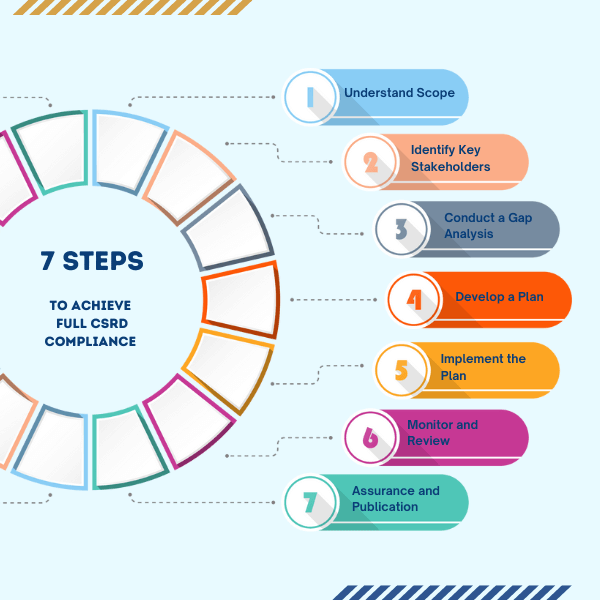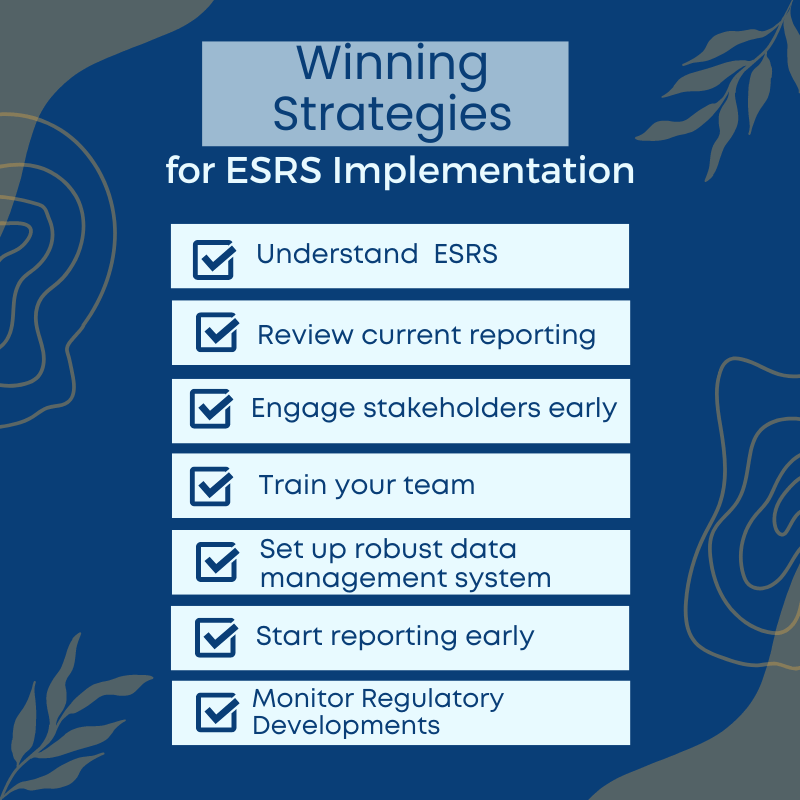In today’s business world, sustainability reporting is not merely a trendy term but holds significant importance in the contemporary business landscape. It’s a crucial component of corporate responsibility, transparency, and stakeholder engagement. And the European Union is at the forefront of this trend with its comprehensive Corporate Sustainability Reporting Directive (CSRD). If you’re wondering how to implement CSRD for your company, this quick guide will walk you through the process step by step.

What is CSRD?
CSRD, or Corporate Sustainability Reporting Directive, is a new regulation published by the European Union in 2022 that aims to improve the sustainability information disclosed by companies. The directive seeks to establish a common set of European sustainability reporting standards (ESRS) and requirements across all member states, including guidelines for sustainability reporting. The CSRD also states that non-EU companies with activities in the EU must adhere to the same reporting requirements. The directive notably requires companies to report on material sustainability information in alignment with the EU taxonomy, which provides a classification system for economic activities that contribute to climate change mitigation and adaptation. In addition to quantitative disclosures, the CSRD requires companies to provide qualitative information on how sustainability matters affect their business, known as the “double materiality” approach.
The CSRD goes beyond the scope of the non-financial reporting directive (NFRD) to cover more than 50 000 companies with operations in the EU. The required disclosures should reflect the company’s impact on environmental, social and governance (ESG) factors, allowing stakeholders to better assess a company’s sustainability performance.
Overall, the CSRD represents a significant step forward in promoting transparency and accountability in corporate sustainability reporting.
7 Steps to Achieve Full CSRD Compliance
In the following section, we present 7 Steps to Achieve Full CSRD Compliance, a comprehensive guide that outlines the key actions and considerations for businesses to ensure compliance with the Corporate Sustainability Reporting Directive (CSRD) and embrace sustainable practices in today’s evolving regulatory landscape.
Step 1: Understand the Scope and Requirements of CSRD
The first step to CSRD compliance is to gain a thorough understanding of the directive’s requirements and the scope of the CSRD that is applicable to your context. This involves knowing which group of companies does yours belong to, and hense the reporting timeline applicable to your company. Please take a look at our blog Demystifying CSRD: Timelines for Companies for detailed explanation on the implementation timelines for different types of companies who must comply with the CSRD.
You also need to know what kind of information you’re expected to disclose. The CSRD covers:
1. General disclosures: Companies must disclose high-level sustainability information as outlined in the standard ESRS 2: General dislcosures, especially the double materiality assessment process. This standard also include other disclosure requirements such as basis for preparation of sustainability report, governance, strategy, Impact, risk and opportunity management, metrics and targets.
2. Environmental matters: This includes details about your business’s impact on the environment, such as greenhouse gas emissions, water and air pollution, and waste management. Companies must always dislose sustainability information as required in ESRS E1: Climate Change. They should also disclose material information following a rigorous double materiality assessment process for other environmental standards: E2: Pollution, E3: Water and marine resources, E4: Biodiversity and ecosystems and E5: Resource use and circular economy.
3. Social matters: This inlcudes detailed disclosures on sustainability information related to social matters, including human rights as outlined in the four ESRS social standards. Specifically, companies must always disclose serveral matters (disclosure requirements S1-1 to S1-9) related to its own workforce following the ESRS S1: Own workforce. For other social matters, companies will apply a rigorous double materiallity assessment process to identify and disclose other material sustainability matters. These matters are related to other key elements in the four standards, S1: Own workforce, S2: Workers in the value chain, S3: Affected communities, S4: Consumers and end-users. These social standards covers various aspects related to human rights and labor rights.
4. Governance matters: Although there is only one governance standard in the ESRS set, which is the G1: Business conduct, companies will have to report on various sustainability matters. These include corporate culture, management of relationships with suppliers, anti-corruption and anti-bribery measures, political influence and lobbying, protection of whistleblowers, animal welfare, and payment practices, especially with regards to late payment to small and medium enterprises (SMEs).
Step 2: Identify the Key Stakeholders
The next step is to identify the key stakeholders who will be involved in the CSRD adoption process.
Stakeholders encompass individuals or groups with the potential to influence or be impacted by a company or project’s activities. These stakeholders can be categorized into two primary groups: those directly affected and those who rely on sustainability statements. The directly affected stakeholders are individuals or groups whose interests are directly impacted by the actions and operations of the company. On the other hand, stakeholders who rely on sustainability statements include investors, creditors, regulators, and others who utilize sustainability information to make informed decisions.
It is crucial to acknowledge that certain stakeholders can fall into both categories, as their interests are affected by the company’s activities while also utilizing sustainability statements for decision-making. Additionally, there are other common categories of stakeholders, such as employees, suppliers, customers, local communities, and authorities, who have a vested interest in the company’s sustainability practices and outcomes.
To effectively demonstrate compliance with the CSRD and ESRS, companies or projects must recognize the significant role of stakeholder engagement in their double materiality assessment process and overall sustainability reporting endeavors. By actively involving both internal stakeholders (such as employees) and external stakeholders (such as affected communities, worker representatives, and trade unions), companies can gain valuable insights and identify the most relevant issues for their stakeholders.
Involving a wide array of stakeholders will help ensure that your sustainability reporting is comprehensive and reflective of your company’s diverse impacts. Remember, successful CSRD compliance requires cross-functional collaboration. Take a look at our blog Impact of ESRS on Stakeholder Trust and Engagement in corporate sustainability reporting for additional information on stakeholder engagement in the CSRD context.
Step 3: Conduct a Gap Analysis
Once you understand the requirements and have identified the key stakeholders, the next step is to conduct a gap analysis. This involves assessing your current sustainability reporting practices and identifying what’s missing or needs improvement to meet the CSRD and ESRS requirements.
As you conduct the gap analysis, ask yourself: what sustainability information are we currently reporting? How are we measuring and tracking this information? Are there areas where we’re not currently collecting data but need to report according to the CSRD/ESRS? This process will help you identify your strengths, weaknesses, and areas for improvement in your sustainability reporting process.
In this gap analysis, do keep in mind the views of investors and other stakeholders. This will help ensures your improved sustainability reporting process meet the needs and expectations of such stakeholders.
While it may seem counter-intuitive, our experience suggests that companies already subject to the NFRD may face greater challenges compared to those starting from scratch, as the latter can bring in fresh perspectives when assessing their gaps. Moreover, the latter seems to have a more relaxed deadline for implementing the CSRD/ESRS.
Step 4: Develop a Plan
Based on the findings of your gap analysis, develop a plan for implementing the changes needed to achieve full CSRD compliance. This plan should detail what changes need to be made, who will be responsible for implementing them, and a timeline for when they should be completed.
Your plan might include actions like improving data collection methods, developing new sustainability initiatives, enhancing reporting processes, and conducting training sessions for employees on CSRD and ESRS requirements.
If you are a large, listed company with more than 500 employees, we encourage you to develop the plan NOW! Do not wait further because the CSRD is applicable to your company in 2024 and your ESG reporting in 2025 must disclose information according to the CSRD/ESRS. Do not underestimate the complexity of new requirements in the CSRD/ESRS.
Step 5: Implement the Plan
With a plan in hand, the next step is to put it into action. This is often the most challenging part of the process, as it requires sustained effort and coordination across different parts of your organization, and sometimes different countries if you are reporting sustainability issues in a consolidated management report.
As you implement the plan, remember to communicate regularly with all stakeholders about progress and any obstacles that arise. This will help keep everyone on the same page and ensure that the implementation process moves forward smoothly.
We recommend companies to form a reporting team which has diverse backgrounds and experience in ESG topics. This will support the smooth implementation of the plan.
Considering that the CSRD and ESRS are new to everyone, it is worth considering the use of external service providers to assist in the development and implementation of your plan. External support can bring fresh perspectives and provide additional resources.
The CSRD Compass offers a broad range of services dedicated to CSRD/ESRS compliance. Visit our website to explore the services we provide. We also offer comprehensive courses that provide detailed explanations of each ESRS requirement, along with examples showcasing proper implementation. Additionally, you can access free courses offered by The CSRD Compass to gain a deeper understanding of the CSRD and ESRS.
Step 6: Monitor and Review
Once you’ve implemented your plan, it’s important to continually monitor your progress and review your sustainability reporting practices. This will help you ensure ongoing compliance with CSRD and identify any areas that need further improvement.
Remember, CSRD compliance isn’t a one-time task—it’s an ongoing commitment. By regularly reviewing and updating your practices, you can ensure that your company stays in line with the directive’s requirements and continues to enhance its sustainability performance.
Step 7: Report Assurance and Publication
It is crucial to emphasize that CSRD reports require external assurance from independent service providers. We briefly covered the topic of assurance in sustainability reporting during our CSRD Course. We are actively working on developing a separate course dedicated to assurance, and we will keep you informed about its release through our newsletter and LinkedIn updates. Stay tuned to receive the latest updates on our upcoming course.
Finally, after all these steps, you’re ready to compile and publish your CSRD report. Ensure that your report is clear, comprehensive, and in line with the requirements in the ESRS 1: General requirements. Don’t forget to make it accessible to all relevant stakeholders, from employees to investors to the public.
Implementing CSRD might seem like a daunting task, but with a clear understanding of the requirements, a well-thought-out plan, and a commitment to sustainability, it’s an achievable goal. By adopting CSRD, you won’t just be complying with regulations—you’ll also be taking a major step toward a more sustainable and transparent business future.
Moving Forward…
Embracing CSRD compliance is a powerful statement of your organization’s commitment to transparency, sustainability, and corporate social responsibility. It signifies a deep recognition of the interconnectedness between businesses, society, and the environment. While the journey towards full CSRD compliance may be complex, the rewards are manifold. By meticulously following this guide and persistently striving towards your sustainability goals, your organization stands to not only meet regulatory requirements but also fortify its reputation, enhance stakeholder relationships, and contribute meaningfully to a sustainable global economy. In today’s business landscape, embarking on the path to CSRD compliance is not just a strategic move—it’s a proactive step towards building a resilient, sustainable future.


